-
Car Reviews
- All reviews
- Midsize SUVs
- Small cars
- Utes
- Small SUVs
- Large SUVs
- Large cars
- Sports SUVs
- Sports cars
- Vans
Latest reviews
- Car News
-
Car Comparisons
Latest comparisons
- Chasing Deals
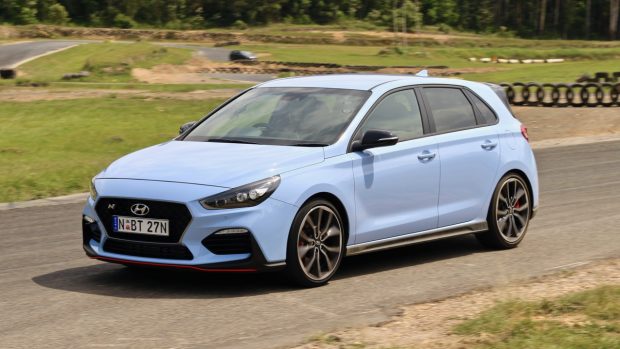
Here’s a new name that will send a shiver down the spine of cars like the Volkswagen Golf GTI: the Hyundai i30 N. Korea’s first hot hatch is still some way off its final production form and an autumn arrival in Australia, but Chasing Cars was among a very small group of local media invited last week to sample two final-stage prototypes on a closed circuit in northern New South Wales. Likely to arrive in February or March in two versions – a sub-$40,000 184kW/353Nm standard car, plus a punchier, pricier 202kW Performance Pack version with a mechanical front-end differential – the i30 N is one of the most anticipated product launches of 2018. And while we’ll have to drive it on the road to draw detailed conclusions, on first impressions, we believe that on arrival, the i30 N will offer the best all-round performance hot hatch experience for under $50,000.
Far from a car that has come out of nowhere, the i30 N – Hyundai’s first real effort at building a road-going performance car – has been a meticulously planned concept. The execution of that concept is unfolding as you read this piece, and watch our first i30 N track drive video above. At surface level, the i30 N appears as merely another hot hatch – a rival for classics like the Volkswagen Golf GTI and Honda Civic Type R – but in reality, this inaugural product of Hyundai’s N motorsports division is the culmination of years of toil and investment from Hyundai headquarters.
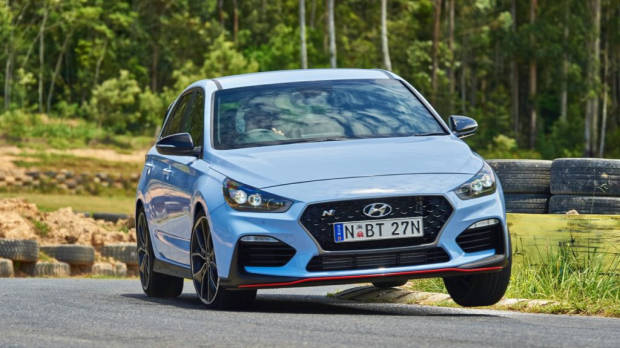
To be honest, we felt a strong sense of trepidation approaching our very early first drive in the i30 N. The weight of expectation is genuinely strong with this vehicle. Underneath the brash Performance Blue paint job are thousands of hours of development at Hyundai’s skunkworks at Namyang, South Korea. There has been more than ten thousand kilometres of testing at the Nurburgring in Germany. Hyundai embarked on an executive talent acquisition programme to run N – it’s headed up by former BMW M engineering head Albert Biermann. And then there’s the fact that this car is as good as Hyundai can do right now: they’ve cut no corners. The i30 N idling here in pit lane has the best set of dynamic equipment that Hyundai can fit, while still delivering a super-sharp predicted price: under $40,000 for the standard car; definitely under $50,000 for the Performance Pack: well under an equivalent Volkswagen Golf GTI, or Golf R.
All the expectation riding on the i30 N is brought home by the fact that today’s hot hatch market is very rich. We’ve thrashed the new Honda Civic Type R around Hobart’s Baskerville Circuit, declaring its darty front end to be the best of the current pack. The all-paw Ford Focus RS has over 250kW of power. And, of course, there is a new set of performance Volkswagen Golfs that arrived a couple of months ago to a positive reception: an updated, 169kW front-drive GTI, and the more focussed 213kW four-wheel-drive Golf R. So, today is a big day. With both the 184kW and 202kW versions available to sample over a whole afternoon, we’re keenly aware of the contested space Hyundai will soon be moving into.
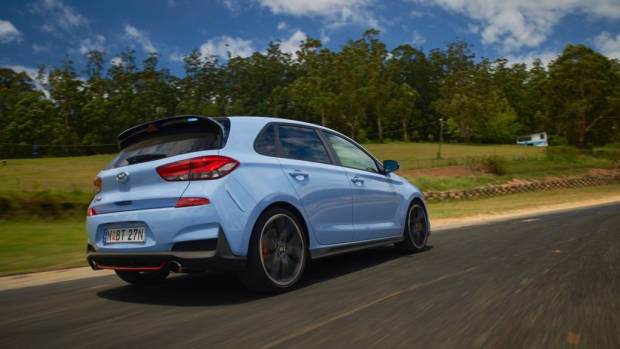
Before we drive the i30 N, we’re keen to talk over that market with Hyundai Australia’s general manager of public relations, Bill Thomas. While Thomas recognises the archetype of this segment – the Golf GTI – as “liveable and comfortable”, he has no hesitation in pointing out that the i30 N is “a more serious and capable car than a GTI – it’s certainly more of an enthusiast’s car, capable of running all day at a track quite easily.” Despite the fact that the i30 N will compete with the Golf GTI on price – if it’s offered, the ‘base’ N will undercut a GTI five-door manual ($41,490), Thomas agrees that the i30 N is a more natural rival to the more focussed class of hot hatches that includes the Ford Focus RS and Honda Civic Type R.
What’s definite is that Australia will receive the i30 N Performance Pack. This version of the N uses the uprated 202kW (270 horsepower) tune of the turbo four, and receives bigger brakes, 19-inch wheels in Pirelli P Zero rubber, a more exaggerated exhaust, and a mechanically-locking, electronically-controlled front differential. However, the decision remains unmade on whether Australia will also take the cheaper, 184kW (247 horsepower) standard form i30 N, which relies on torque vectoring by braking and runs smaller wheels. However, while he wouldn’t confirm it either way, Thomas said it was “likely” the lower-end car would make it down under carrying an attractive price “starting with a 3” – or, under $40,000.
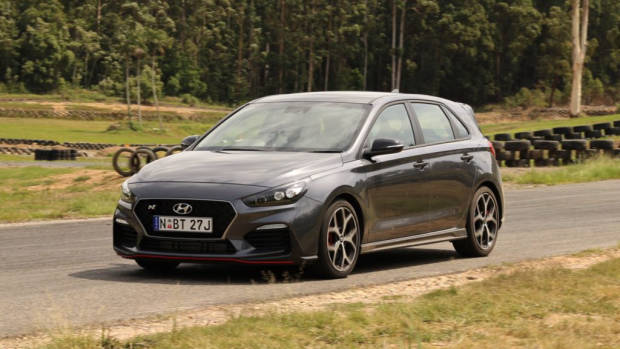
The ‘base’ i30 N.
We agree to revisit that discussion, because a burbling i30 N – the standard car – is now available for track duty. We decided to have our first taste of N in this base car in order to get a feel for what a buyer will have access to for less than $40,000. Our base tester was painted dark grey and sat on innocuous-looking 18-inch wheels, shod in 225/40R18 Michelin Pilot Super Sports rubber – certainly an understated counterpoint to the conspicuous Performance Pack prototype running 19s, and finished in N’s halo colour, a pastel named Performance Blue.
Within a quartet of laps of Coffs Harbour’s Raleigh circuit, it’s clear that the ‘base’ i30 N is a deeply compelling proposition at a sub-$40K price. Our initial perception of this lower 184kW/353Nm tune of the 2.0-litre engine was that it pulls hard – but less linearly – than the Golf GTI’s 169kW/350Nm four-pot. The base car dispatches the 0-100km/h sprint in 6.4 seconds but the experience isn’t about the engine. The biggest differentiator is immediately the feel of the Hyundai, which clearly sits well toward the track end of the comfort-sports continuum of hot hatches. It’s an impression conveyed by the chunky, low-mounted buckets (manual and fabric in standard form), the beefy blue-stitched steering wheel with immediate shortcuts for five drive modes and rev matching, and of course, by the ball-head shifter for the six-speed manual. That’s the only gearbox available: an eight-speed dual-clutch automatic won’t arrive until 2019.
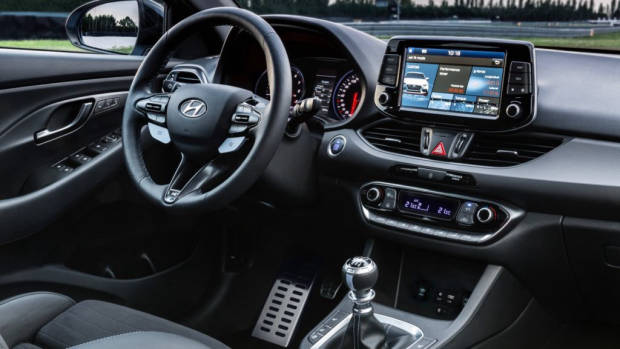
Thankfully, it’s a decent manual. The mid-length throw feels second-best to the Civic Type R’s typically excellent Honda stick, but a light clutch with predictable bite makes the i30 N easy to pedal around at slower speeds or drive in anger on track. The ergonomics of the whole situation are solid: the shifter is right where your left hand falls and the steering wheel sits at a natural distance, though I found myself wanting the wheel to adjust down a little further. As for the immediate lack of a paddle-shifted dual-clutch, Hyundai are keenly aware this limits the breadth of appeal in Australia, with Thomas conceding this factor “defines a certain set of owners, whether we like it or not”. However, similarly-priced sporty cars like the Mazda MX-5 do manage majority-manual volumes – so Australians might surprise us and buy the i30 N in quantity regardless. As for local sales expectations: Hyundai remain tight-lipped.
We were relieved to discover that the base i30 N makes a really good sound out of its twin exhausts: there are plenty of pops and crackles, and these are especially audible outside the car. Though the Performance Pack is specifically marketed as possessing a beefed-up exhaust, owners of the base car won’t be disappointed, though it is a little more sedate inside. Indeed, the base car is quieter overall – there’s less tyre noise through the Michelins (which actually heat up quicker, and coped with the small, tight Raleigh circuit better than the Performance Pack’s Pirellis), and the single-mode exhaust is more hushed in the cabin.
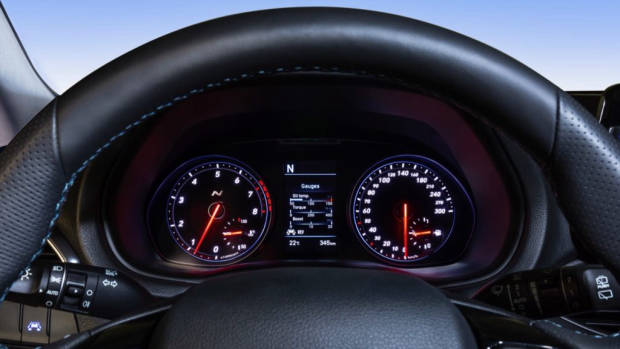
It’s immediately clear that the i30 N has benefitted from substantial steering development. Power assistance has been moved from the wheel to the rack – and while we liked the steering of the regular 150kW/265Nm i30 SR, launched earlier this year – the N’s tiller is much more direct and communicative. The weighting remains a little too light for our tastes, but the level of driver connection to the enthusiastic front end leaves no room for disappointment. That front end isn’t quite as alive and overtly impressive as that in the Honda Civic Type R, but it isn’t far off – a feat when you consider that this stock i30 N will undercut the new Honda by around $13,000.
The ride feels more compliant than expected, and not brittle – although we spent the entirety of our time on a surprisingly rutted track, driving in anger in a mix of N mode and N custom mode. These are the top two of five drive modes (softer modes are available: Normal, Sport, and, hilariously, Eco). Both modes relax the stability control tune, which feels pretty well-attuned to loose Australian desires, and they firm up the steering weight – though it’s still fairly light. However, it’s actually plain-old N mode that is sits the i30 into the hardest damping on the adaptive suspension. N Custom mode actually slackens that firmness to allow more wheel motion, helping the i30 N to find more grip.
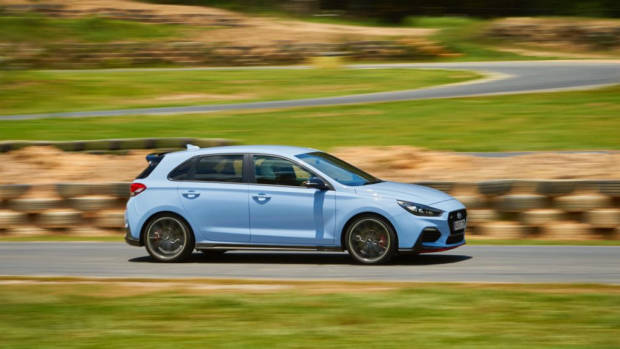
So, the base i30 N, which will carry that deeply attractive price point, is pacey, fun, focussed and well-rounded. Admittedly, it looks a little too inoffensive in grey and on smaller wheels (no word on whether Performance Blue will be available on this lower-end model). But the biggest problem with the base car is the lack of a proper front differential. 184kW is more than sufficient to bamboozle the front wheels with big throttle on corner exit – torque vectoring by braking is better than nothing, but it tends to stomp out power, and thus fun. Over my twenty minutes or so with the lower-end i30 N, I was pining for a real diff.
And then I got it: the Performance Pack might go and stop faster thanks to more power and bigger brakes, and it might sound louder inside and out due to its bi-modal exhaust, but the only key differentiator to the base car is the mechanically-locking, electronically-controlled, two-stage front differential. If you plan to drive the i30 N hard – and we predict its owners will, given the manual-only nature and explicit track focus – then the Performance Pack will be worth the extra spend, which we’re predicting to be an additional outlay of about $6,000. The best hot hatches, in our books, are front-wheel-drive and pack a true front-end differential: the new Civic Type R, various Renault Megane RSs, the Volkswagen Golf GTI 40 Years that thrilled us last year.
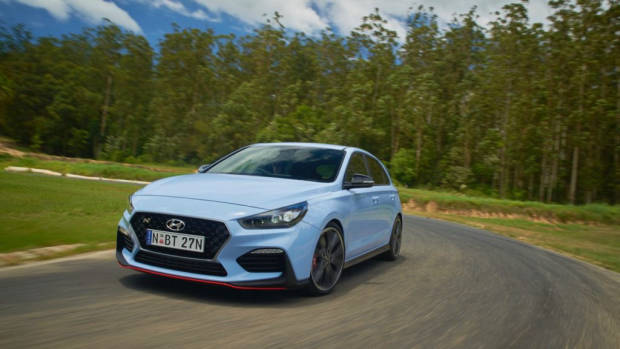
Just as it does for those cars, the differential works to sparkling effect on the i30 N Performance Pack. The squabbling-for-grip phenomenon is all but gone, with a now-tenacious set of front wheels keenly bolting to the tarmac on corner exit, ready to haul the N’s mass towards the next entry. It’s telling that the tyre squeal is almost gone, replaced only with a dull thudding from the P-Zeros measuring 235/35R19 that Hyundai co-developed with Pirelli, the sidewalls copping abuse as we gained confidence in the Performance Pack’s extremely competent cornering ability. This car will be able to sustain really impressive cornering speeds – Raleigh circuit is small and tight but we’re filled with enthusiasm for a proper high-speed blast at a larger track or on an excellent road.
Helping to justify the additional spend on the Performance Pack is the marginally more upmarket cabin it unlocks. The base car’s manually-operated, fabric-trimmed seats are swapped out for heated leather-and-alcantara pews with electric adjustment at least for the driver. The blue highlights remain, visible in the seat stitching, the boot of the gear shifter, and on the steering wheel shortcuts. As the N model uses the underlying cabin of the new PD-generation i30, it’s well laid-out, with a high-set touchscreen with dedicated N gauges and controls. The bucket seats felt comfortable and supportive (though our time in the saddle was relatively short). Unfortunately, like the standard i30, the use of hard plastics is too expansive – they’re found on the dash and where the driver’s leg comes to rest. A sunroof will be optional on both i30 N versions, although Hyundai expects local take-up to be very low, with no plans to fit out a press car with the feature.
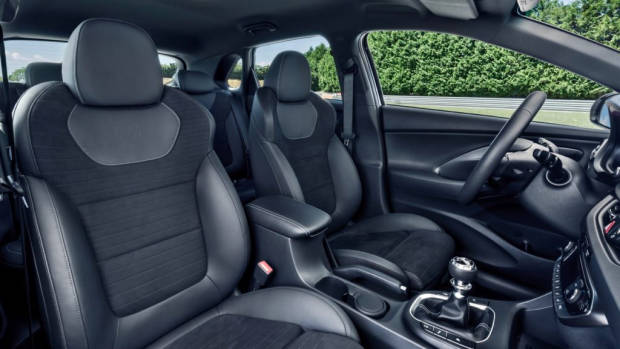
Interestingly, given that at present just one trim grade is actually confirmed for Australia, Hyundai are talking up the potential of a local four-model range where the base grade and the Performance Pack are each supported by a ‘Luxury’ grade; under such a plan, the fabric seats would be standard on each car while a Luxury option, like that seen on the Volkswagen Golf GTI, would add the heated leather-alcantara seats and potentially additional features that would be stripped out of the normal grades. Mr Thomas wouldn’t be held on when we’ll know for sure, but the makeup of the range won’t be known until after Christmas.
It’ll take a good road drive in the Hyundai i30 N to determine exactly how good it is, vis-a-vis the competition. One of the best parts of cars like the Volkswagen Golf GTI, and the new Honda Civic Type R, is their flexibility – both are comfortable on road and entertaining when driven hard. We’ve come away from our early experience with the N certain of its capability in the latter class – the i30 N is seriously fun, and this Hyundai is an accomplished vehicle on track. In the track context, the N lies at the upper end of the performance hatch class. But how good is it on the road? How driveable is it everyday? Those are the questions that will have to wait until the car launches to the Australian market in February/March 2018 – and when it does, we’ll be back with an even more comprehensive review.
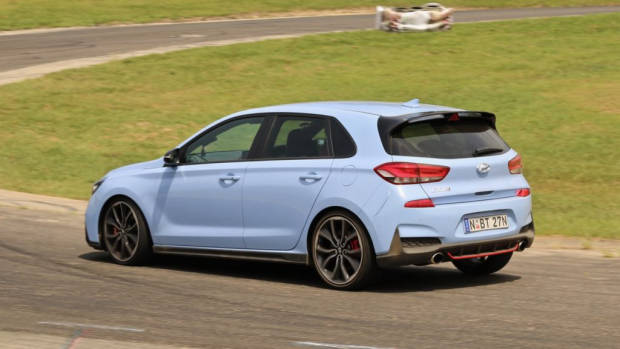
Key specs (as tested)
About Chasing cars
Chasing Cars reviews are 100% independent.
Because we are powered by Budget Direct Insurance, we don’t receive advertising or sales revenue from car manufacturers.
We’re truly independent – giving you Australia’s best car reviews.
The estimate provided does not take into account your personal circumstances but is intended to give a general indication of the cost of insurance, in order to obtain a complete quote, please visit www.budgetdirect.com.au. Estimate includes 15%^ online discount.
^Conditions Apply
Budget Direct Insurance arranged by Auto & General Services Pty Ltd ACN 003 617 909(AGS) AFSL 241 411, for and on behalf of the insurer, Auto & General Insurance Company Limited(ABN 42 111 586 353, AFSL 285 571).Because we don’t know your financial needs, we can’t advise you if this insurance will suit you. You should consider your needs and the Product Disclosure Statement before making a decision to buy insurance. Terms and conditions apply.
Indicative quote based on assumptions including postcode , 40 year old male with no offences, licence suspensions or claims in the last 5 years, a NCD Rating 1 and no younger drivers listed. White car, driven up to 10,000kms a year, unfinanced, with no modifications, factory options and/or non-standard accessories, private use only and garaged at night.
^Online Discounts Terms & Conditions
1. Discounts apply to the premium paid for a new Budget Direct Gold Comprehensive Car Insurance, Third Party Property Only or Third Party Property, Fire & Theft Insurance policy initiated online on or after 29 March 2017. Discounts do not apply to optional Roadside Assistance.
2. Discounts do not apply to any renewal offer of insurance.
3. Discounts only apply to the insurance portion of the premium. Discounts are applied before government charges, taxes, levies and fees, including instalment processing fees (as applicable). The full extent of discounts may therefore be impacted.
4. We reserve the right to change the offer without notice.